Glossy kitchen in the interior: pros and cons, ideas for use
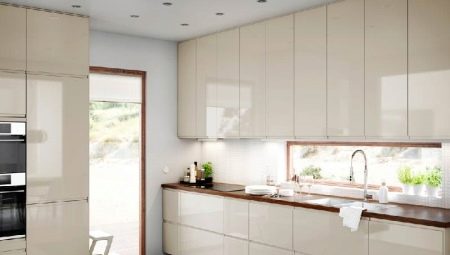
Refined gloss invariably attracts attention with its texture, shimmering shine and rich shades, which is why it has found great demand in the design of stylish kitchen interiors. Supporters of non-trivial solutions in decor have long been using glossy surfaces to decorate kitchen facades, thereby creating a spectacular and expensive setting in the room.

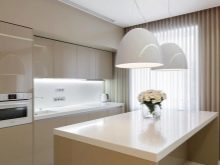

Advantages and disadvantages
The main advantage of gloss comes down to creating opportunities for the implementation of the most interesting design solutions, thanks to which you can design a truly unique interior, making the kitchen a favorite place for all household members.
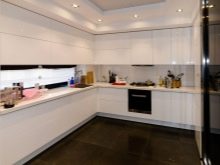
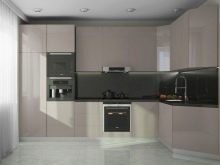
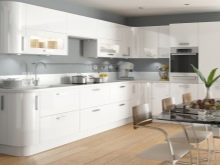
The secret to the success of gloss lies in its exceptional decorative and performance characteristics.
- Due to the special structure of the coating, gloss has the property of reflecting light rays, thereby visually expanding the kitchen space and filling it with light. Such solutions are popular in both large and small apartments.
- Gloss harmoniously fits into most styles, and a wide color palette will satisfy the most demanding customers and choose a material for them that will harmoniously combine with the overall color concept of the room.
- The surfaces are easy to use and can be cleaned with the simplest and most affordable means.
- Glossy details retain their color for a long time, do not fade and do not lose their saturation over time.
- Facades made of such materials are environmentally friendly, during operation they do not emit harmful and toxic substances. Moreover, a layer of plastic can protect family members from formaldehyde fumes, which are often emitted by chipboard panels.
- Glossy facades are distinguished by their elegance and festive look. The material looks very aesthetically pleasing, so be sure that you are guaranteed a great mood and a good appetite!
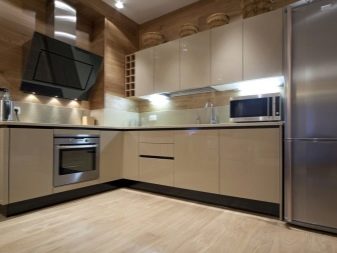
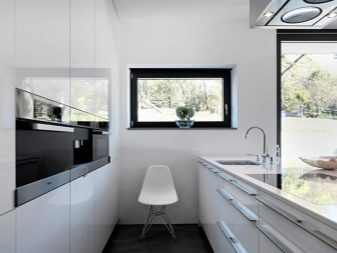
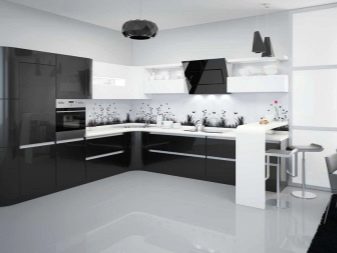
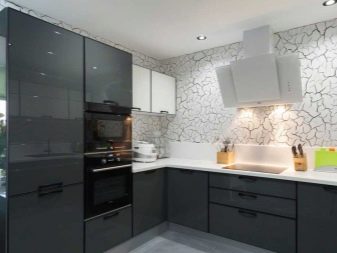
At the same time, one should not forget about the disadvantages. Expect any stains, splashes, handprints or other contaminants to be immediately visible on the glossy finish.
Such panels require regular cleaning, otherwise the overall perception of the kitchen will be untidy.
For in order not to engage in round-the-clock washing of a glossy surface, give preference to a non-monochromatic coating, and models with textured splashes of silver and gold shades. It should be noted that the gloss is not very durable, any dents and scratches will entail the need to replace all parts.
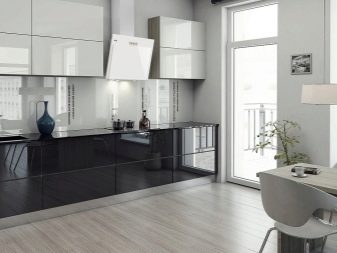
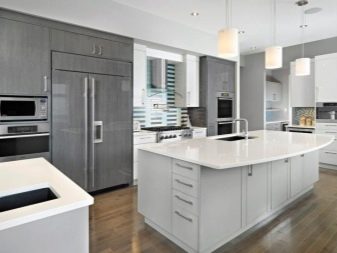
Comparison to matte kitchen
First, let's figure out why glossy surfaces are better than matte ones.
It should be noted that for many decades matte facades remained the only available option, therefore, the hostesses did not have to choose. Gloss is popular these days, but each type of coating has its pros and cons.


So, matte facades are more practical than glossy... If small children live in your house, then they will most likely leave handprints on all surfaces that will be in their access zone - in this case, the use of matte facades will be more justified.


Alternatively, you can combine matte bottom and glossy top of the modules.
It is easier to care for a matte kitchen - it needs to be cleaned much less often. But this cannot be said about the gloss - streaks remain on it, any dirt is immediately striking, so you need to wipe the coating with a damp cloth several times a day. In addition, glossy facades can be scratched. It is much more difficult to spoil matte surfaces.
But the gloss looks more spectacular - due to the reflectivity, such surfaces visually expand the kitchen space and make it lighter. The decorative properties of such a coating are very high - glossy facades will become a luxurious option, which gives even the most dull objects a winning look.

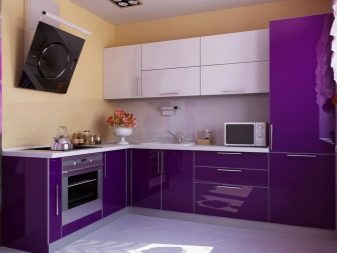
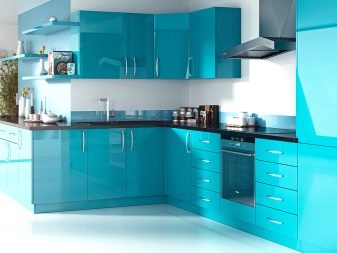
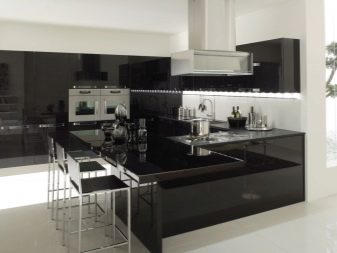
Thus, on the side of matte coatings - good quality, on the side of gloss - aesthetics and luxury. The choice is only yours.
Manufacturing materials
Most often, in the manufacture of glossy modular facades, MDF with a film coating is used. The main distinguishing feature of the material is the ability to create absolutely any design, ranging from monochromatic gloss to using the technique of photo printing according to your sketch.
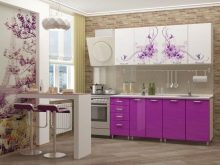


Plastic facades are considered an alternative to MDF. They are usually made from furniture boards and then laminated. It is the laminate that gives them a glossy shine. It is easy to take care of such kitchen modules, they are not afraid of moisture, they are not afraid of scratches and temperature fluctuations.
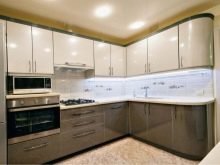

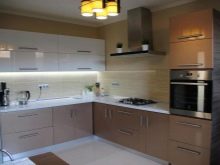
In recent years, glass modules are often used for the manufacture of glossy kitchens. Such facades look very expensive. For production, not ordinary, but tempered glass is used. It is strong, durable, clean and easy to damage.
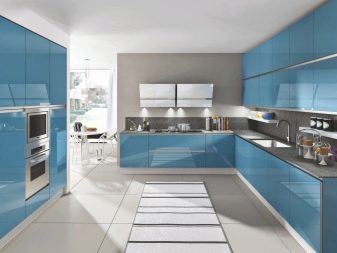
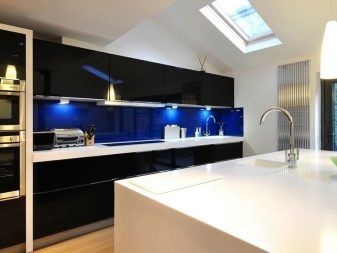
Such furniture is not cheap at all, but it will serve faithfully for many years without losing its original gloss.
Facade type
When making a choice in favor of glossy furniture, be sure to ask the seller what material the facades of the modules are decorated with, since the degree of gloss, as well as wear resistance, durability, and the final cost of the headset, largely depends on them.


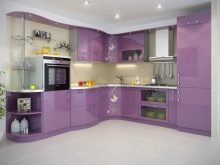
Acrylic is the most durable type of glossy finish. It is distinguished by its practicality, durability and environmental safety. Acrylic plastic has the ability to withstand elevated temperatures, it does not deform under the influence of steam and water, does not fade over time, and it shines more than all other types of glossy coatings. At the same time, acrylic surfaces can only be deaf, options for decorating with panels or milling are impossible, therefore, most often designers recommend purchasing furniture with glass inserts in an aluminum frame.


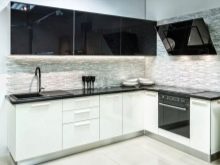
This solution looks very harmonious, but at the same time and significantly increases the cost of the kitchen module.
HPL is a material that is better known as pressure laminated plastic. Such a coating has a thickness of 0.3-2 mm, is highly resistant to wear and tear, but shines less than acrylic. For those who want a moderate shine on surfaces in their kitchen, this choice will be optimal. Headsets made using such a coating belong to the low and medium price segments.
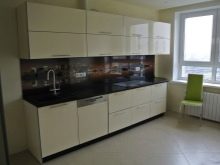


A glossy surface is often obtained by varnishing, and in this case, you can get almost any shade, as well as interesting textures, for example, mother of pearl, chameleon and metallic. The surfaces covered with varnish and enamel are durable, they are not afraid of UV rays, moisture, steam and temperature fluctuations, the coatings do not absorb dirt and grease, and are resistant to scratches. Unlike acrylic, lacquered facades are paneled and milled.

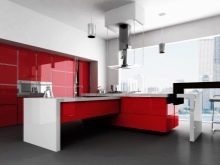
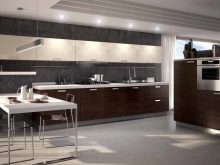
These modules are usually the most expensive.
PVC film shines less than all other coatings, respectively, and it costs much less, therefore, furniture made with its use is attributed to the budget category. Such a coating is easy to scratch; under the influence of high temperatures, it begins to melt, and swells and peels off from the steam.
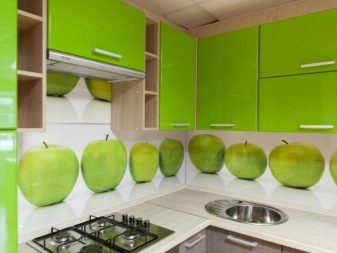

Color solutions
The tint solution of the interior is one of the most difficult issues. The chosen color scheme should meet all your expectations from the interior as much as possible, so it is important to take into account all the initial data: the level of illumination of the kitchen, the availability of free space, the color scheme of the walls, ceiling and floor in the room.

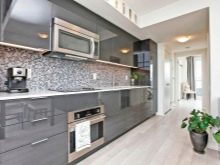
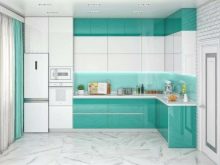
White gloss in the kitchen will be airy, light and light. Headsets made in this color look quite elegant, harmoniously combined with any other tones. White gloss is good for small spaces as it helps to visually expand the kitchen and improve illumination by reflecting light rays.
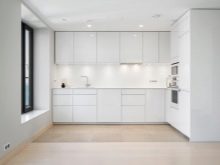

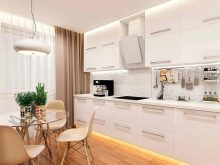
If a black matte surface looks dull and dull, then a glossy one, on the contrary, is considered an extravagant option that truly amazes with its chic and luxury. Contrary to popular belief, the use of gloss black does not darken the kitchen, as it has the ability to reflect light. When choosing this solution, try not to overdo it with the dark. Usually it is combined with a light background, steel and golden shades. The best option is considered to be the design of the kitchen in black and white, while the smaller the space, the greater the dominance of white should be. This technique allows you to add space and fresh air to the room.
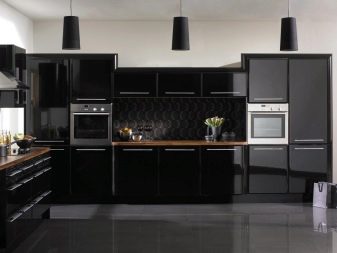
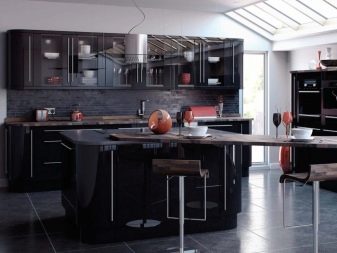
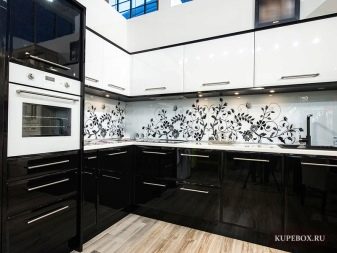

If we make the main shades of black, then the attention of the guests will be focused on the mysteriousness and mystical mystery of the room.
Red makes any kitchen livelier and more beautiful. At the same time, it is better to be careful with rich tones, as they quickly start to irritate. To avoid this, it is advisable to combine red gloss with beige, gray and other calm tones.

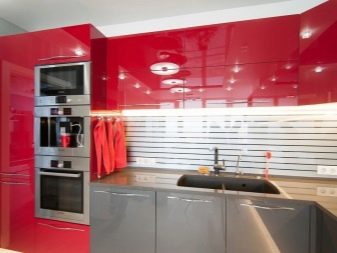
Green in tandem with a glossy effect has the ability to illuminate the space and fill it with harmony.The green color palette has many shades that can be combined with each other, therefore, the room can always be decorated in green tones, using its different tones.
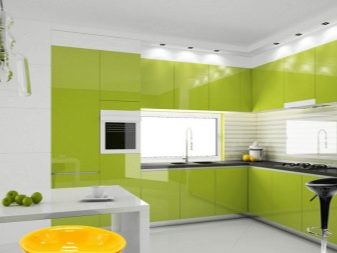

The use of beige gloss is considered a universal solution. A light atmosphere will bring notes of warmth and comfort to the room; in such a kitchen it will be pleasant to hold meetings with relatives and friends and arrange family gatherings. You can combine the beige palette with any colors. The color is often used in tandem with gray, as well as black and red.

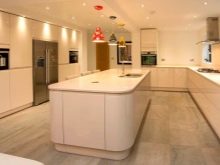
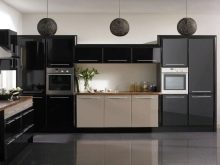
A kitchen with a yellow palette invariably evokes the most positive reaction. This playful option is the smart choice for north-facing kitchens as it fills the space with light.
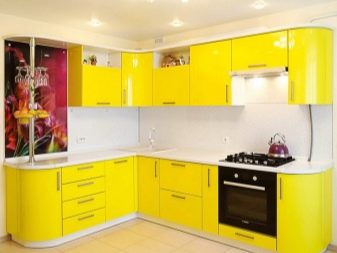

While you don't need to overwhelm your kitchen, it's best used in conjunction with whites, browns and reds.
The violet color scheme allows you to make the room sophisticated and noble. Lilac shades are not annoying, since they are considered quite muted, but it is still advisable to combine this tone with white or any other neutral color.
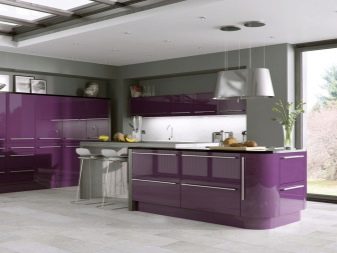
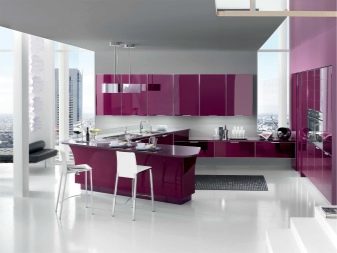
What styles is it suitable for?
Glossy kitchens look spectacular in a wide variety of styles.
- High tech - this is an ultra-modern direction, which is perfectly emphasized by gloss. The style is high-tech, prefers an abundance of glass, chrome and all kinds of technology, so here you need to use graphite, black and white coatings.
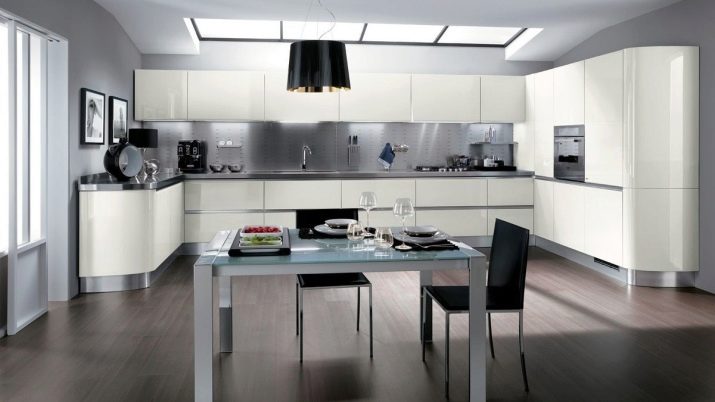
- Minimalism - in this case, it is important not to allow any unnecessary elements, laconic geometry of lines and symmetry are welcomed here. Appliances are usually built-in. This style is functional. Here, gray, black, white-blue and yellow glossy surfaces are most often used.
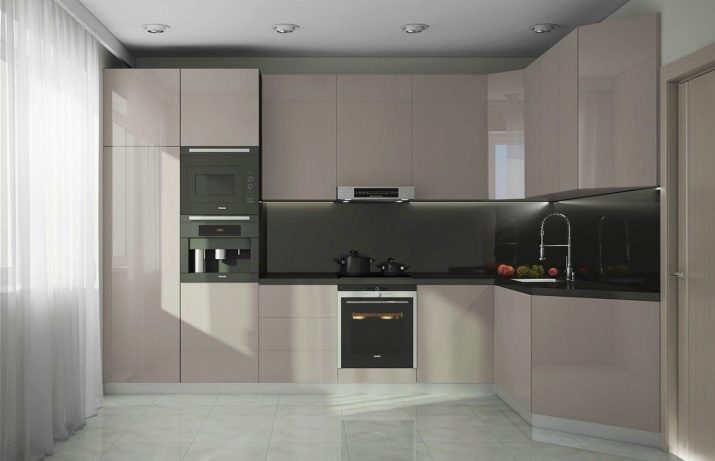
- Modern - this style is a symbiosis of classics and hi-tech, it is characterized by a combination of traditional design and modern technology. Here, glossy elements can be made in different shades, glass surfaces and metal elements are allowed.
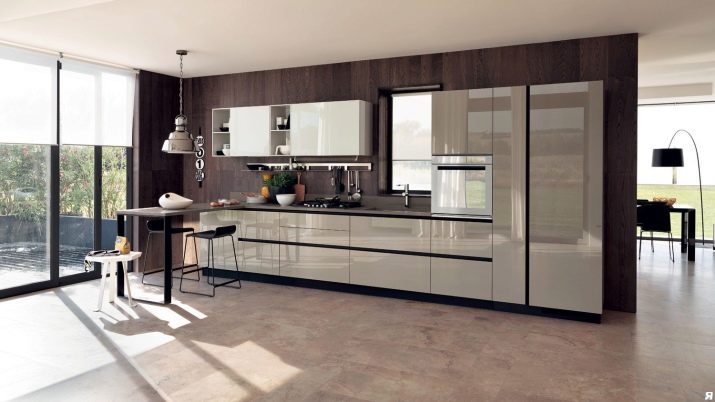
Care advice
Glossy surfaces in an apartment require constant maintenance, otherwise the kitchen quickly takes on an unaesthetic look. For cleaning, use soft wipes and the simplest products (soap solution, shampoo, shower gel or window cleaner). The use of aggressive compounds is unacceptable, as in this case the color may "float". Do not use abrasive powders either - they can scratch the surface.


Once a week, it is advisable to polish the surface with special pastes - these can be purchased at any hardware store.
In order for your glossy facades to retain their impeccable appearance for as long as possible, it is important to keep the room dry, avoid mechanical shock and contact with sharp objects.
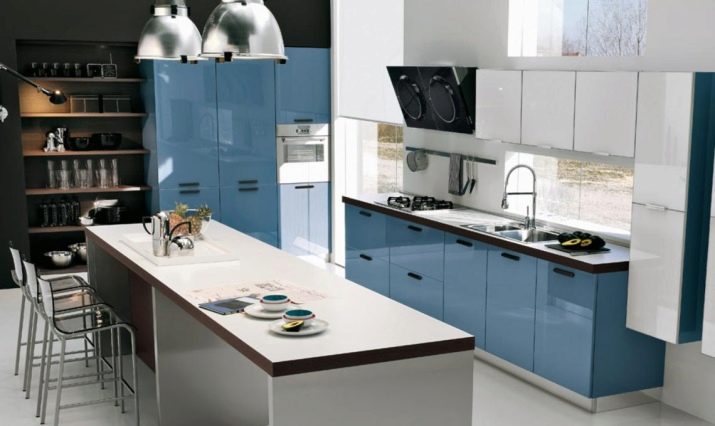
For a glossy kitchen in the interior, see the video below.








